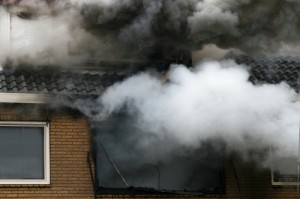 An air duct system is very efficient at spreading smoke. When a fire occurs, the entire HVAC system will be contaminated, to a lesser or greater degree. It is likely that the air duct system will distribute smoke damage well beyond the area of the fire.
An air duct system is very efficient at spreading smoke. When a fire occurs, the entire HVAC system will be contaminated, to a lesser or greater degree. It is likely that the air duct system will distribute smoke damage well beyond the area of the fire.
Smoke Damage from an Active Air Duct System
Unfortunately, a forced air ventilation system is rather effective at spreading smoke damage. Smoke is drawn into return air vents, through the furnace components, and distributed throughout the home or building through the supply air ducts. If the HVAC system was operating at the time of fire, the return air side will be the most contaminated.
Passive Air Duct Smoke Damage
Even if the heating and ventilation system is not in use, there is a natural or passive air movement throughout the ventilation system. If the air duct system wan not in operation during the fire, the return and supply air ducts closest to the fire will be the most contaminated.
Absorption of Odors
Smoke is naturally attracted to metal surfaces and is corrosive in nature. As the smoke enters the air ducts it will cling to the steel, and will absorb into the debris within the air duct system. A ventilation system has to be thoroughly cleaned in order to remove smoke damage.
Odor Oxidizer
After the ventilation system has been cleaned, an odor oxidizer is applied within the air ducts. An odor oxidizer naturally breaks downs the odor causing chemicals of the smoke damage.
Encapsulation
In some instances of extreme smoke damage, air ducts will need to be encapsulated to remediate the smoke damage. After the air ducts are cleaned, an encapsulates approved for use within HVAC systems is applied uniformly throughout the ventilation system.

